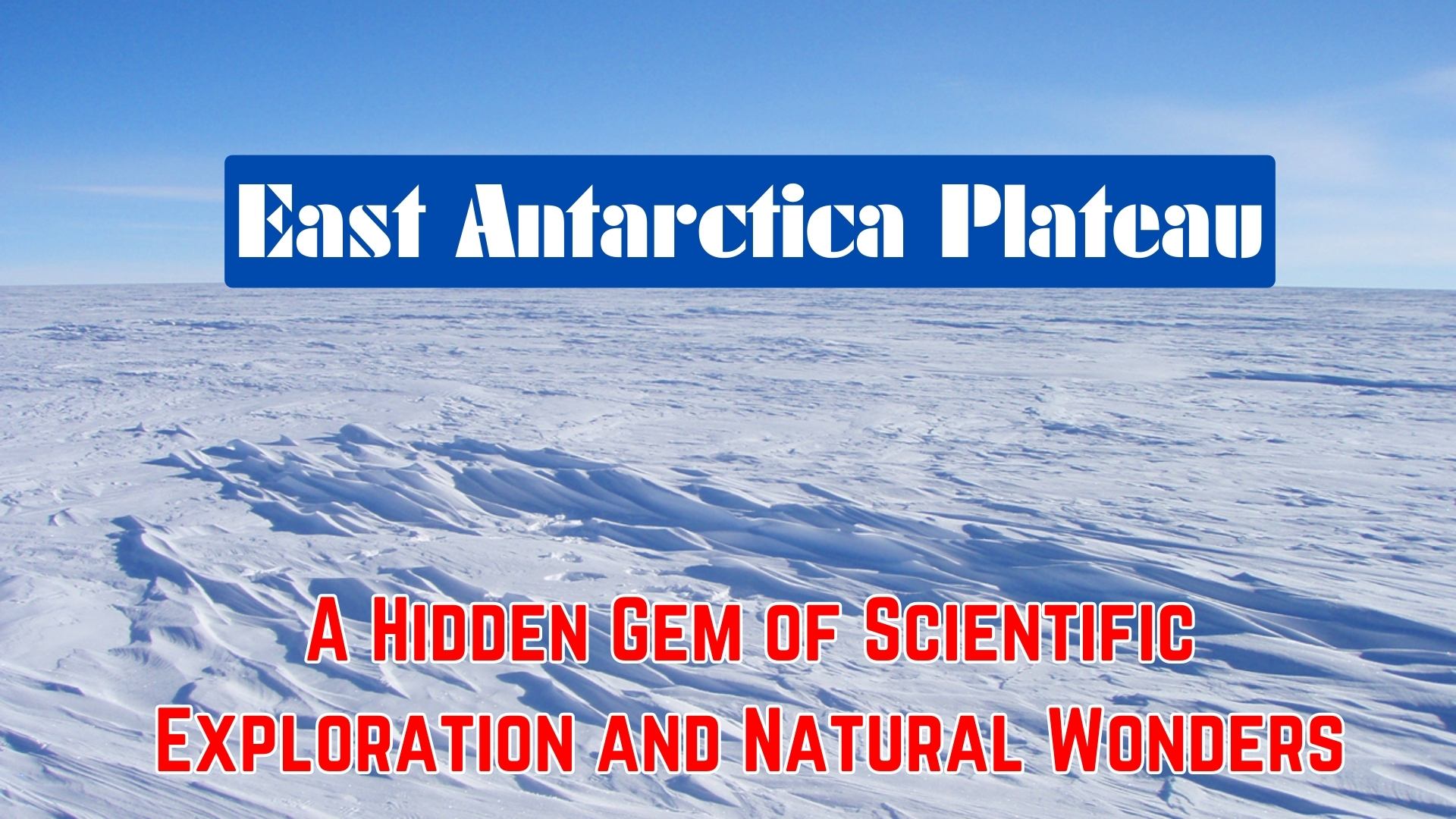East Antarctica Plateau : Located in the heart of Antarctica, the East Antarctica Plateau is a mesmerizing destination that has captivated the attention of scientists and explorers for decades. This vast, icy landscape stretches across millions of square kilometers, offering a glimpse into the Earth’s geological history and hosting a diverse range of unique ecosystems. As one of the most remote and inhospitable places on the planet, the East Antarctica Plateau remains largely unexplored, holding untold secrets waiting to be discovered. In this article, we will delve into the geological significance of the plateau, explore its climate and weather patterns, uncover its rich biodiversity, and shed light on the scientific research and discoveries that have emerged from this remarkable region.
The Geological Significance of the East Antarctica Plateau

The East Antarctica Plateau is a geological marvel, formed by millions of years of tectonic activity and glacial processes. Comprising ancient rocks dating back billions of years, this vast expanse of ice provides scientists with a window into the Earth’s past. The plateau is home to some of the oldest rocks ever discovered, including evidence of ancient supercontinents and the remnants of long-extinct mountain ranges. By studying the rocks and geological formations of the East Antarctica Plateau, scientists have been able to reconstruct the history of our planet and gain insights into the processes that have shaped it over billions of years.
Climate and Weather Patterns in the East Antarctica Plateau
The East Antarctica Plateau is renowned for its extreme climate and harsh weather conditions. With average temperatures dropping well below freezing and wind speeds reaching hurricane force, this icy wilderness poses significant challenges to those who venture into its depths. The region experiences long, frigid winters and short, cool summers, with limited precipitation in the form of snowfall. The high elevation of the plateau results in a dry and cold climate, making it one of the driest places on Earth. These unique weather patterns have a profound impact on the ecosystem and influence the distribution of ice and snow across the plateau.
Biodiversity and Unique Ecosystems in the East Antarctica Plateau
Despite its seemingly inhospitable conditions, the East Antarctica Plateau is home to a surprising array of biodiversity and unique ecosystems. The surrounding ocean serves as a vital source of nutrients, supporting a diverse range of marine life, including whales, seals, and penguins. In addition, the plateau itself harbors a variety of organisms that have adapted to survive in this extreme environment. Microscopic algae and bacteria thrive in the snow and ice, forming colorful blooms that create a vibrant tapestry across the landscape. These organisms are not only fascinating in their own right but also play a crucial role in the global carbon cycle, influencing climate patterns on a larger scale.
Scientific Research and Discoveries in the East Antarctica Plateau
The East Antarctica Plateau has been a hotbed of scientific research and discoveries for decades. Scientists from around the world flock to this remote region to study its unique geology, climate, and ecosystems. By drilling deep into the ice, researchers have been able to extract ice cores that contain invaluable information about past climate conditions and atmospheric composition. These ice cores have provided crucial insights into the Earth’s climate history, helping scientists understand the mechanisms driving climate change today. Furthermore, the East Antarctica Plateau has yielded fossil discoveries, shedding light on the evolution of ancient life forms and the history of our planet.
Next Article: Explore the Enchanting Beauty of Wayanad: Top 10 Wayanad Tourist Places
Natural Wonders and Attractions in the East Antarctica Plateau
Beyond its scientific significance, the East Antarctica Plateau is also home to a breathtaking array of natural wonders and attractions. Towering ice cliffs, sculpted by centuries of wind and ice, create a stunning backdrop against the stark white landscape. Glacial lakes and ice caves dot the plateau, offering glimpses into a hidden world beneath the ice. The plateau is also home to majestic icebergs, some of which are the size of small islands. These awe-inspiring formations come in a variety of shapes and colors, creating a surreal and otherworldly atmosphere. For those fortunate enough to witness these natural wonders, the East Antarctica Plateau is a truly unforgettable experience.
Challenges and Future Prospects for Exploration in the East Antarctica Plateau
Exploring the East Antarctica Plateau is not without its challenges. The extreme climate, treacherous terrain, and logistical difficulties make it a formidable task. However, advancements in technology and increased international collaboration have opened up new possibilities for scientific exploration in this remote region. With the development of specialized vehicles and equipment, scientists can now probe deeper into the ice and reach areas that were once inaccessible. As we continue to push the boundaries of knowledge, the future prospects for exploration in the East Antarctica Plateau are promising, with the potential for groundbreaking discoveries that could reshape our understanding of the planet.
Conservation Efforts and Preservation of the East Antarctica Plateau
Recognizing the importance of preserving the unique environment of the East Antarctica Plateau, international efforts have been made to protect this pristine wilderness. The Antarctic Treaty System, signed by over 50 countries, designates Antarctica as a natural reserve dedicated to peace and science. Strict regulations are in place to minimize human impact and ensure the conservation of the region’s delicate ecosystems. Scientists and researchers working in the East Antarctica Plateau adhere to strict guidelines to prevent contamination and preserve the integrity of their research. These conservation efforts are crucial in safeguarding this remarkable place for future generations and ensuring that scientific exploration can continue in a sustainable and responsible manner.
Visiting the East Antarctica Plateau – Travel Tips and Recommendations
Visiting the East Antarctica Plateau is a unique and once-in-a-lifetime experience. However, due to its extreme conditions and remote location, it is not a destination for the faint of heart. Travel to the plateau is typically facilitated by specialized tour operators and research expeditions. When planning a visit, it is essential to be well-prepared and equipped for the harsh environment. Warm, waterproof clothing, sturdy footwear, and appropriate gear are essential. It is also important to adhere to all environmental guidelines and regulations to minimize impact on the fragile ecosystem. By following these travel tips and recommendations, visitors can make the most of their time in the East Antarctica Plateau and have a safe and memorable journey.
Conclusion: The East Antarctica Plateau – A Must-Visit Destination for Scientific Enthusiasts and Nature Lovers Alike
In conclusion, the East Antarctica Plateau is a hidden gem of scientific exploration and natural wonders. From its geological significance and extreme climate to its rich biodiversity and groundbreaking discoveries, this remarkable region offers a wealth of opportunities for scientific inquiry and awe-inspiring experiences. As we continue to unravel the secrets of this icy wilderness, it is essential that we do so with a sense of responsibility and conservation. By preserving the East Antarctica Plateau and promoting sustainable exploration, we can ensure that future generations can also enjoy the wonders and mysteries of this unique destination. For scientific enthusiasts and nature lovers alike, a journey to the East Antarctica Plateau is an unforgettable and transformative experience.




